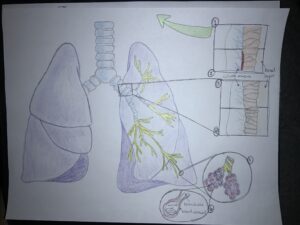This is showing the structures of the lower respiratory system. It relates to my essay which discusses some of the toxins found in most types of smoke and the damage they can do to different tissues in the respiratory system.
\

This is showing the structures of the lower respiratory system. It relates to my essay which discusses some of the toxins found in most types of smoke and the damage they can do to different tissues in the respiratory system.
\
Rachel found a common theme between her classes, Human Anatomy and Physiology and Firefighting and decided to expand on that with her STEAM project. The objective she covered was “Compare and contrast the function and structural characteristics of tissues,” and she did this by presenting some of the tissues found in the respiratory system and illustrating what can happen to them if toxins from smoke are inhaled. She chose to compare the effects on alveolar tissue, respiratory mucosal tissue, and bronchial tissue. The visual included was a detailed illustration of the respiratory system showing the trachea, bronchus, bronchioles, and the lungs. With this drawing, Rachel does a considerable job at highlighting the location and structure of the alveolar, respiratory mucosal, and bronchial tissue by including magnified depictions of each one. This helps give context to her research and demonstrates to people, who may be unknowing of the structure of the lungs, what she is referring to when she describes respiratory system tissue.
While researching she found that the simple squamous epithelium that make up the alveolar tissue, in charge of helping conduct the transportation of oxygen from inhaled air to the bloodstream, can be damaged by carbon monoxide found in smoke. Inhaling carbon monoxide allows it to bind to the hemoglobin in place of the oxygen and eventually affect oxygen being delivered to the body. Rachel also mentioned that the mucosal cells found in the respiratory tract are made of columnar stratified epithelium and ciliated pseudostratified columnar epithelium, both with goblet cells. Combusting synthetics and wood can produce aldehydes and organic acids that can wear away the mucosal cells. The worn away tissue is then infected easier. With the bronchial tissue composed of ciliated pseudostratified columnar epithelium with goblet cells, chlorine can affect it by killing the outer layer. Another toxin acrolein, when inhaled, causes the protein cross-strands and single DNA strands to break apart and prohibit cell production. Rachel clearly demonstrated that toxins from smoke need to be taken seriously based on their threat to our respiratory system.